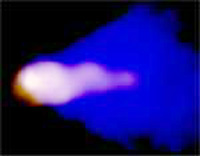This area deals with the fundamental laws and building blocks of nature and how they interact, the properties and the behavior of matter, and research into space and time and their structures.
innovations-report provides in-depth reports and articles on subjects such as astrophysics, laser technologies, nuclear, quantum, particle and solid-state physics, nanotechnologies, planetary research and findings (Mars, Venus) and developments related to the Hubble Telescope.

Computer models of Earth’s climate have consistently linked long-term, high-magnitude variations in solar output to past climate changes. Now a closer look at earlier studies of the Sun casts doubt on evidence of such cycles of brightness, their intensity and their possible influence on Earth’s climate. The findings, by a solar physicist and two climate scientists funded by the National Science Foundation (NSF), appear in the October 1 issue of the journal Science.
“The relationshi

A new class of very small handheld devices can detect motion a thousand times more subtly than any tool known.
“There was nothing in the [optics] literature to predict that this would happen,” says Sandia National Laboratories researcher Dustin Carr of his group’s device, which reflects a bright light from a very small moving object.
Sandia is a National Nuclear Security Administration laboratory.
Carr, who earlier gained fame as a graduate student at Cornell

In a nod to scientific paradox, researchers at the University of California, Berkeley, have slowed light down in an effort to speed up network communication.
They have shown for the first time that the group velocity of light – the speed at which a laser pulse travels along a light wave – can be slowed to about 6 miles per second in semiconductors. While that speed is not exactly the pace of a turtle, it is 31,000 times slower than the 186,000 miles (or 300 million meters) per seco

A Supernova Early Warning System (SNEWS) that detects ghostlike neutrino particles that are the earliest emanations from the immense, explosive death throes of large stars will alert astronomers of the blasts before they can see the flash.
SNEWS “could allow astronomers a chance to make unprecedented observations of the very early turn-on of the supernova,” wrote the authors of an article about the new system in the September issue of the “New Journal of Physics” http://www.iop.org

Today, September 29, 2004, is undisputedly the Day of Toutatis, the famous “doomsday” asteroid.
Not since the year 1353 did this impressive “space rock” pass so close by the Earth as it does today. Visible as a fast-moving faint point of light in the southern skies, it approaches the Earth to within 1,550,000 km, or just four times the distance of the Moon. Closely watched by astronomers since its discovery in January 1989, this asteroid has been found to move in an orbit that bring

Astronomers have used an X-ray image to make the first detailed study of the behavior of high-energy particles around a fast moving pulsar. The image, from NASA’s Chandra X-ray Observatory, shows the shock wave created as a pulsar plows supersonically through interstellar space. These results will provide insight into theories for the production of powerful winds of matter and antimatter by pulsars.
Chandra’s image of the glowing cloud, known as the Mouse, shows a stubby b